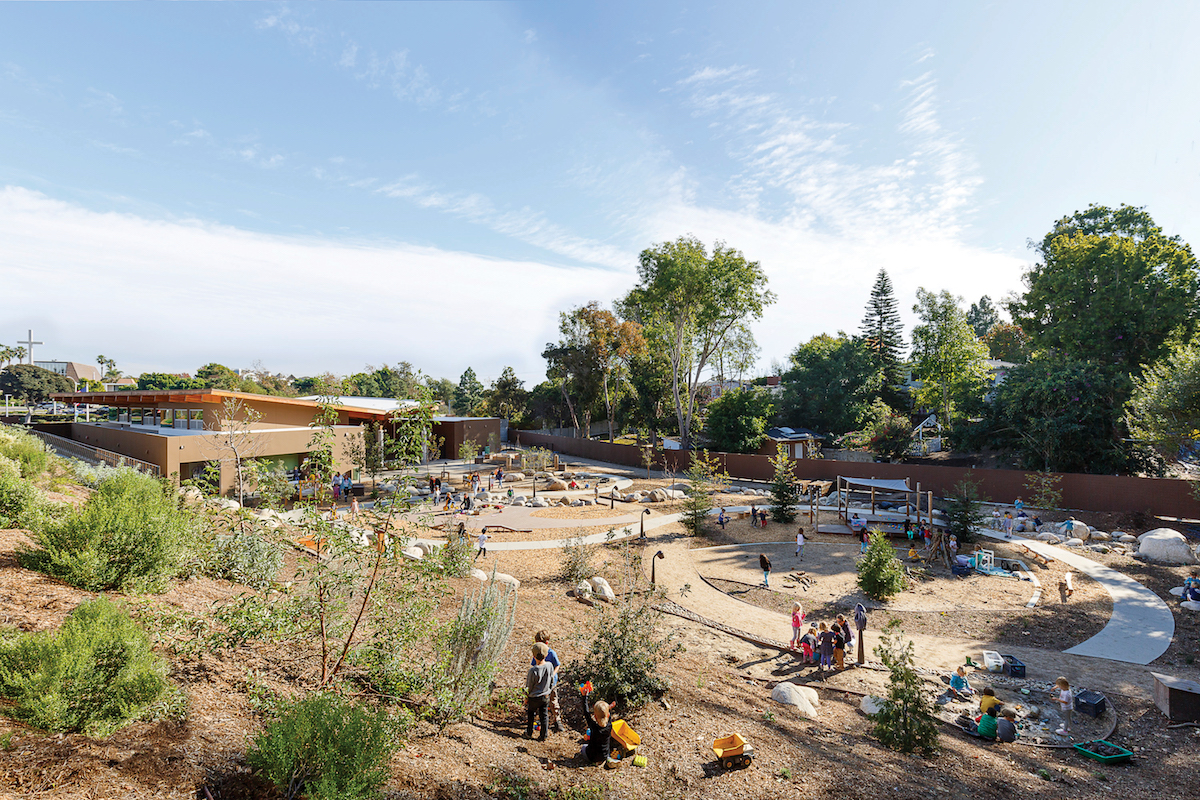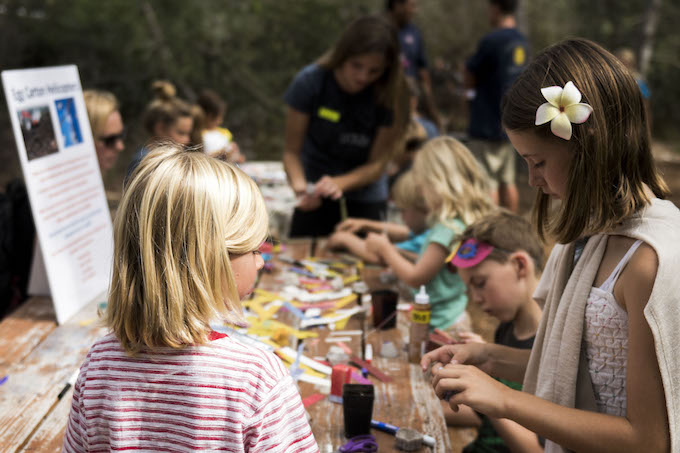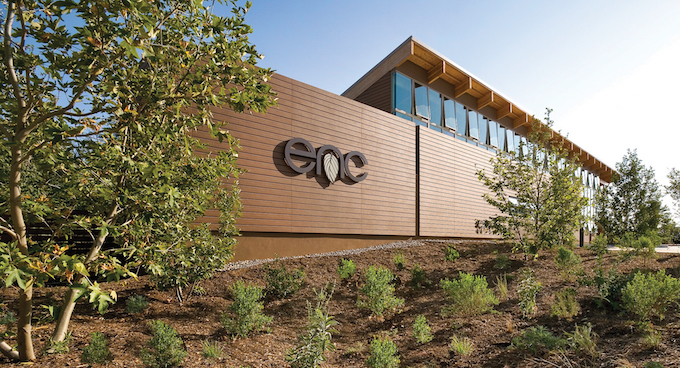
For 50 years, the Environmental Nature Center has given locals a chance to escape into tranquility and make a connection with the natural world.
By Ashley Ryan
Immersing oneself in nature isn’t the easiest task in Orange County, where sidewalks and buildings reign supreme. And even when you do manage to step outside—at the beach, a small park, a hiking trail—you’ll often find you weren’t the first to have the same idea.
Luckily, the Environmental Nature Center offers a slice of serenity, and a chance to escape, right on the edge of town. In fact, this year marks 50 years since the center’s humble beginnings.
“You hear so often about natural areas shrinking and becoming less than they once were, … but we’ve been able to expand our footprint and that’s pretty special,” says Bo Glover, longtime executive director of the ENC. “It speaks to the needs identified by our community [as well as] the desire of those here at the nature center to fulfill our mission and to make sure that this nature center is here for generations to come.”
The main focus at the center is highlighting the 15 California plant communities that can be found within its fences, but the story does not end there. With a butterfly house, camps for kids, evening programming, educational experiences, expansions and more, the ENC’s history is a long one, yet it’s simultaneously just getting started.
Back to the Beginning
While the ENC officially got its start in 1972, the idea came much earlier. Robert House, the founder, would vacation each year with his parents near Mount Whitney in the Sierra Nevada mountains, riding horseback in the saddle behind his mother as early as 4 years old. “That was my introduction to the real wilderness,” he says.
House’s passion for the outdoors only grew from there, as he went on to work for a pack train company before serving as a park ranger in Yosemite National Park, a vertebrate ecologist at the Audubon Camp of the West in Wyoming and, eventually, a biology teacher at Newport Harbor High School.
It was during his time at Newport Harbor that his aspiration of opening a nature center was realized. And while it is now a stunning 5 acres of tranquil terra, that was not always the case. Although the land was owned by the high school, it was basically an overgrown gully that served as a drainage ditch for local neighborhoods. “It was just a weed patch down there,” House recalls.

So in 1972, he approached Norman Loats, the deputy superintendent of the Newport-Mesa Unified School District, about launching the ENC. He was supportive and plans began to move forward. “At that time, it was to benefit the students of Newport Harbor with the intent to eventually become a community resource as well,” Glover explains. “None of the trees that you see now at the center were there. There was no stream.”
But classes were established at the high school, with staff bringing students over to build trails, plant flora and even create the waterway. Notably, when the school decided to put in an Olympic-size pool, House convinced them to deposit all of the dirt in the gully rather than taking it to the dump, allowing them to create more topography at the property.
As for the vegetation, House was teaching a Coastline College class on native plants when he had the idea to incorporate plant communities specific to California. “Because of our topography—[with] the lowest [elevation] at Death Valley and the highest at Mount Whitney and the ocean on one side—we have more diversity of plant life than any other spot in North America,” he explains. He enlisted the help of another teacher, John Echternach, to procure plants that grew naturally across the state, which wasn’t easy at the time due to the number of non-native species around.
“Having grown up in the wilderness myself, I wanted to create a wilderness feeling for all ages,” House notes. “… This facility is kind of an offshoot of what I’ve always dreamed of.”

The land where the center is located was shared by the school district’s headquarters at the time that it opened, but since then, much has changed. Glover began working at the center in 1991, first as a volunteer then a naturalist, becoming more involved as his passion for the organization grew. A few years later, an embezzlement scandal within the district put the center at risk. “We were a separate nonprofit organization, but we were still very much a part of the school district,” Glover notes, adding that 80% of the ENC’s funding was coming from Newport-Mesa.
Recognizing a need to add separation between the center and the district, Glover proposed that the board of directors hire him in an executive director role. “I saw that if a financial crisis happened again and the nature center lost that school district support, it would be in real trouble and it might not survive something like that,” he explains. They agreed and, working part time, he raised funds through corporate sponsorships, events and memberships—just in time, as a few years later the county went bankrupt and the school district eliminated funding for the ENC.
“I stepped up at that time,” Glover says. “… But it speaks to the good work that the nature center has always done.” And, like that, they were on their own.
Eventual Expansion
For a time, the ENC struggled, having to outsource much of its programming due to lack of funds and staffing. But they kept fighting until, one day, he saw a land surveyor examining the property where the school district’s buildings stood (the district had since moved its headquarters to Costa Mesa and was renting the buildings to a nonprofit).
When the surveyor told Glover that the district intended to sell the land, he saw a chance to expand. “We looked at that as the opportunity for the nature center to really be on the map and be able to be self-sufficient,” he explains. “… We were getting thousands of kids here for programs, but we were hidden.”
With the help of an advisory council and the patience of Newport-Mesa, the ENC was able to successfully buy the land that fronted the 16th Street property. After that, Glover hired Lori Whalen, the assistant director who has now been there for 18 years. Together, they were able to ensure programs were once more run by the ENC and its new staff.
But they were still working out of modular buildings, until a call from the Harry and Grace Steele Foundation, who asked them to submit a grant proposal for whatever they needed. Mere months later, the ENC was awarded a check for $4.5 million, which allowed it to build an award-winning facility—which houses museum exhibits, a gift shop, classrooms and more—in 2008.

The building earned a platinum rating from the U.S. Green Building Council’s Leadership in Energy and Environmental Design. “We were the first platinum building in Orange County,” Glover says. “And it has certainly served as an example to the community of how to build things better.”
But that was only the start of the expansion. In 2019, another LEED-certified building opened: the ENC Nature Preschool. Located adjacent to the center, the preschool, which serves roughly 72 students between ages 2 and 5, centers around outdoor education, giving students the chance to explore, play and learn in the great outdoors.
“I look at the preschool as a model of how schools should be built. Most of your early childhood programs are out of the backside of a church or in some industrial complex,” Glover says. “… They weren’t designed to be a preschool. The thought as to the beneficial aspects of the surroundings weren’t considered.”
The outdoor classrooms are the site of everything from sensory learning and building to art and music, with the majority of the day spent outdoors. In fact, despite school closures due to the COVID-19 pandemic, the year-round ENC Nature Preschool was able to remain open the entire time, thanks to social distancing, mask policies and the open air setting.
According to Glover, the kind of outdoor education the children are receiving at the preschool is unparalleled. “I can pick our preschoolers out of a crowd like that,” he notes. “Their coordination is just so much better than the other kids—their curiosity, their confidence. It’s just amazing to me.”
Before the pandemic, Glover says they were serving 23,000 kids a year between school tours, scout troop visits, community events and the preschool. And with last year’s acquisition of the Tucker Wildlife Sanctuary in Modjeska Canyon, the ENC is spreading that educational bubble even further.
The 12-acre property, which has walking trails, a bird watching deck and a museum, has been operated by California State University, Fullerton, for the last 50-plus years. “Then they shuttered the facility,” Glover shares. “As part of the deed, the land reverted back to … the San Fernando Valley Audubon Society. Nobody on the board knew that they had this responsibility of Tucker, because in 1968, it transferred to Fullerton. It wasn’t on anyone’s radar.”

As such, this Audubon Society chapter sought out new stewards, deeding the land to the ENC in July 2021. It is currently closed for renovation (though some programming is taking place there), but Glover hopes it will be open for public access in the coming months. “We’ve been peeling back the layers,” he explains. “Over the years, you can imagine, with a property like that, there have been various states of repair and disrepair. … But it’s a treasured facility for the community.”
Although the main task right now is getting rid of non-native, invasive species of plant life, Glover says the ENC team may also bring in more native vegetation, with the site to represent the ecosystem of the Santa Ana Mountains. Programming, while similar to that of the ENC, will be unique to the region, touching on everything from the flora and fauna of the area to fire ecology and sustainability.
A Lasting Legacy
It’s hard for House to believe that 50 years have passed since he cleaned up the nearby gully and created a natural space for all to enjoy. “I can see it now, though, by looking at how the trees have been growing,” he adds.
With the addition of the main ENC building, the nature preschool and, now, the first off-site expansion with the Tucker Wildlife Sanctuary, it’s clear that hard work and dedication abound at the center. Although House has since retired, Glover has been a prominent steward of the center for more than 30 years now.
“For a lot of kids, this is their first exposure to the natural world. And just seeing the impact on these kids when they come to what truly is a small little piece of nature … drove my passion,” he explains.
Recently, the ENC made changes to its mission statement to further reflect the work it is trying to do there.
“The original mission of the ENC was to provide quality education through hands-on experience with nature,” he notes. “But it really became evident the last few years that we do much more than that, and our mission is not just to educate. Our mission has become to provide transformative experiences through connection with nature.”

With a rise in technology and the number of hours children spend in front of screens, Glover says it is crucial for them to spend time outdoors. “A lot of these kids don’t know where their food comes from,” he adds. “They think it comes from Trader Joe’s or Ralphs or Albertsons. They’ve never been to a farm to see where their food really comes from. They’re spending so much time in front of screens they’ve lost that connection with nature.”
As a child, Glover says he was outdoors exploring all day, told only to come home when the streetlights turned on. “What was I doing?” he asks. “I was building forts, I was digging holes to China, I was turning rocks over in a stream to see what creepy crawlies were underneath there. I was connecting with the world around me. And, for too many kids today, there is not that connection.”
That’s what it’s all about, for him: ensuring that these children that spend time at the ENC are forming last memories and connection with the natural world. “I will always take time when I see a group of kids here to come out and not necessarily interact with them, but just observe their interaction with their surroundings,” Glover adds. “… And that is, by far, the most meaningful thing for me here at the center. … They’re the ones that are going to change the world.”
The last 50 years have brought so much growth to the ENC. From the original 2-acre plot to its now 5 acres of land, a museum space, a nature preschool and wildlife sanctuary, there is plenty to celebrate. But, as the momentum continues, it’s clear that the ENC is just getting started and will be a resource for the community for years to come.
Photos by Environmental Nature Center




